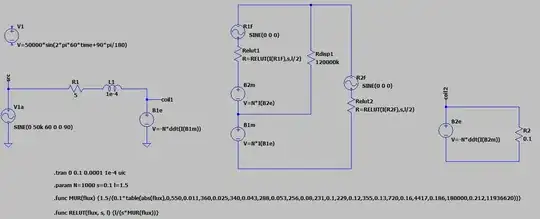I am trying to model a transformer using coupled electrical and magnetic circuits. SPICE has many advantages in assembling these circuits. I was able to model properly for an transformer with no load, although the solution is a little slow.
When I try to add a secondary to the transformer, the simulation is prohibitively slow.
Does anyone have any clue as to what the problem might be?


constant*I(device)choose H or F sources, and, similarly, E or G forconstant*V(node); it's likely you'll have better chances for convergence and get faster results. But, unless I'm wrong, yourMUR(x)seems to bes/l/table(), and thenREL(x,s,l)=l/s/MUR(x), which simplifies totable(). Also, you can accept your own answer, it helps future searches of the same topic, showing an acepted answer. – a concerned citizen Jan 31 '21 at 14:45Flux=<...>) can also be used to model simple saturable inductors. See the link I gave and the manual underLTspice > Circuit Elements > L.for more (if needed). – a concerned citizen Jan 31 '21 at 14:51